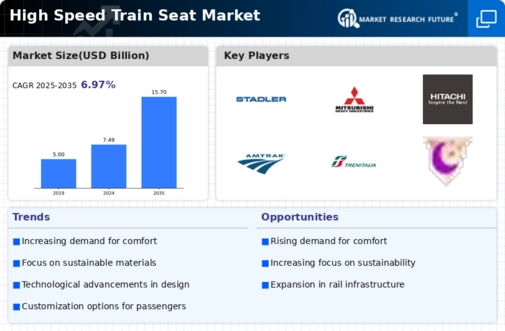Market Growth Projections
The Global High Speed Train Seat Market Industry is projected to experience substantial growth in the coming years. With a market value of 7.49 USD Billion in 2024, it is anticipated to reach 15.7 USD Billion by 2035, reflecting a robust growth trajectory. The compound annual growth rate (CAGR) of 6.97% from 2025 to 2035 indicates a strong upward trend in demand for high-speed train seats. This growth is driven by various factors, including increased urbanization, technological advancements, and government investments in rail infrastructure. The market's expansion is expected to create new opportunities for manufacturers and service providers within the industry.
Increasing Focus on Passenger Comfort
The Global High Speed Train Seat Market Industry is increasingly focusing on enhancing passenger comfort as a key driver of growth. Train operators are recognizing that comfortable seating can significantly impact customer satisfaction and loyalty. Features such as adjustable headrests, spacious legroom, and reclinable seats are becoming standard in high-speed trains. Moreover, the introduction of premium seating options, such as business class and first-class accommodations, caters to diverse passenger needs. This emphasis on comfort is likely to attract more travelers, thereby contributing to the industry's projected CAGR of 6.97% from 2025 to 2035.
Environmental Sustainability Initiatives
Environmental sustainability initiatives are becoming a crucial driver for the Global High Speed Train Seat Market Industry. As global awareness of climate change rises, there is a growing push towards greener transportation solutions. High-speed trains are recognized for their lower carbon footprint compared to air travel and automobiles. For instance, high-speed rail systems can reduce greenhouse gas emissions by up to 75% per passenger kilometer. This environmental advantage is prompting governments and private sectors to invest in high-speed rail projects, further stimulating demand for high-speed train seats. The industry's commitment to sustainability is likely to enhance its appeal in the coming years.
Technological Advancements in Train Design
Technological innovations are playing a pivotal role in shaping the Global High Speed Train Seat Market Industry. Advances in materials science and engineering have led to the development of lightweight yet durable seating options that enhance passenger comfort and safety. For example, the integration of ergonomic designs and advanced cushioning materials has improved the overall travel experience. Additionally, smart seating solutions equipped with charging ports and entertainment systems are becoming increasingly popular. These innovations not only attract passengers but also contribute to the operational efficiency of high-speed trains, thereby supporting the industry's growth trajectory.
Growing Demand for Efficient Transportation
The Global High Speed Train Seat Market Industry is witnessing a surge in demand for efficient transportation solutions. As urbanization accelerates, cities are increasingly seeking alternatives to road traffic congestion. High-speed trains offer a viable solution, reducing travel time significantly. For instance, the average speed of high-speed trains can reach up to 300 km/h, making them an attractive option for intercity travel. This demand is projected to contribute to the market's growth, with the industry expected to reach 7.49 USD Billion in 2024. The emphasis on sustainable transport solutions further enhances the appeal of high-speed rail, positioning it as a key player in the future of transportation.
Government Investments in Rail Infrastructure
Government investments in rail infrastructure are significantly influencing the Global High Speed Train Seat Market Industry. Many countries are recognizing the importance of high-speed rail as a means to boost economic growth and reduce carbon emissions. For instance, nations like China and Japan have heavily invested in expanding their high-speed rail networks, which has led to increased demand for high-speed train seats. This trend is expected to continue, with projections indicating that the market will grow to 15.7 USD Billion by 2035. Such investments not only enhance connectivity but also create job opportunities, further driving the market's expansion.




















